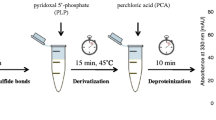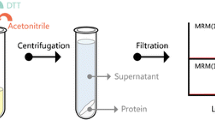Summary
Ion-exchange chromatography (IEC) with ninhydrin post-column derivatisation is the only technique available for the assay of total, (free plus bound), cysteine and homocysteine which also enables the routine measurement of all other commonly occurring amino acids. IEC assay of total cysteine and homocysteine typically involves incubating buffered plasma for 60 minutes at 37°C with dithiothreitol (DTT), but these assay conditions significantly extend total analysis time and compromise other amino acid values, notably glutamine and glutamate. However, it is possible to carry out the DTT reduction in plasma virtually instantaneously and without additional buffering, thus preserving the integrity of other diagnostically important amino acids. Assay precision is adequate for cardiovascular risk assessment.
Similar content being viewed by others
References
Andersson A, Brattstrom L, Isaksson A, Israelsson B (1989) Determination of homocysteine in plasma by ion-exchange chromatography. Scand J Clin Invest 49:445–449
Boers GHJ (1997) The case for mild hyperhomocysteinaemia as a risk factor. J Inherit Metab Dis 20: 301–306
Bonham JR, Moat SJ, Allen JC, Powers HJ, Tanner MS, McDowell I, Bellamy MF (1997) Free homocysteine may be a poor measure of control in homocystinuria. J Inherit Metab Dis 20 [Suppl] 1: 20
Brattstrom L (1996) Vitamins as homocysteine — lowering agents. J Nutr 126: 1276S-1280S
Candito M, Bedoucha P, Mahagne MH, Scavini G, Chatel M (1997) Total plasma homocysteine determination by liquid chromatography before and after methionine loading: results in cerebrovascular disease. J Chromat 692: 213–216
Dawson RMC, Elliot DC, Elliot WH, Jones KM (1990) Biochemical reagents. In: Data for biochemical research, 3rd edn. Oxford University Press, New York, p 381
Kang S, Wong PWK, Becker N (1979) Protein bound homocyst(e)ine in normal subjects and patients with homocystinuria. Pediat Res 13: 1141–1143
Malinow MR (1994) Plasma homocyst(e)inaemia and arterial occlusive disease: a mini review. Clin Chem 41: 173–176
Refsum H, Fiskerstrand T, Guttormen AB, Ueland PM (1997) Assessment of homocysteine status. J Inherit Metab Dis 20: 286–294
Ueland PM, Refsum H, Stabler SP (1993) Total homocysteine in plasma and serum: methods and clinical applications. Clin Chem 39: 1764–1779
Ueland PM, Mansoor MA, Guttormsen AB, Muller F, Aukrust P, Refsum H, Svardal AM (1996) Reduced, oxidised and protein-bound forms of homocyateine and other aminothiols in plasma comprise the redox status — a possible element of the extracellular antioxidant defence mechanism. J Nutr 126: 1281S-1284S
Author information
Authors and Affiliations
Rights and permissions
About this article
Cite this article
Briddon, A. Total plasma homocysteine as part of the routine aminogram by ion-exchange chromatography. Amino Acids 15, 235–239 (1998). https://doi.org/10.1007/BF01318862
Received:
Accepted:
Issue Date:
DOI: https://doi.org/10.1007/BF01318862




